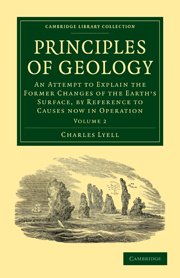 Principles of Geology
Principles of Geology Summary
Having shown in the last chapter how considerably the numerical increase or the extension of the geographical range of any one species must derange the numbers and distribution of others, let us now direct our attention to the influence which the inorganic causes described in our first volume are continually exerting on the habitations of species.
So great is the instability of the earth's surface, that if Nature were not continually engaged in the task of sowing seeds and colonizing animals, the depopulation of a certain portion of the habitable sea and land would in a few years be considerable. Whenever a river transports sediment into a lake or sea, the aquatic animals and plants which delight in deep water are expelled: the tract, however, is not allowed to remain useless, but is soon peopled by species which require more light and heat, and thrive where the water is shallow. Every addition made to the land by the encroachment of the delta of a river banishes many subaqueous species from their native abodes; but the new-formed plain is not permitted to lie unoccupied, being instantly covered with terrestrial vegetation. The ocean devours continuous lines of sea-coast, and precipitates forests or rich pasture-land into the waves; but this space is not lost to the animate creation, for shells and seaweed soon adhere to the new-made cliffs, and numerous fish people the channel which the current has scooped out for itself. No sooner has a volcanic isle been thrown up than some lichens begin to grow upon it, and it is sometimes clothed with verdure, while smoke and ashes are still occasionally thrown from the crater.
- Type
- Chapter
- Information
- Principles of GeologyAn Attempt to Explain the Former Changes of the Earth's Surface, by Reference to Causes now in Operation, pp. 158 - 175Publisher: Cambridge University PressPrint publication year: 2009First published in: 1832
